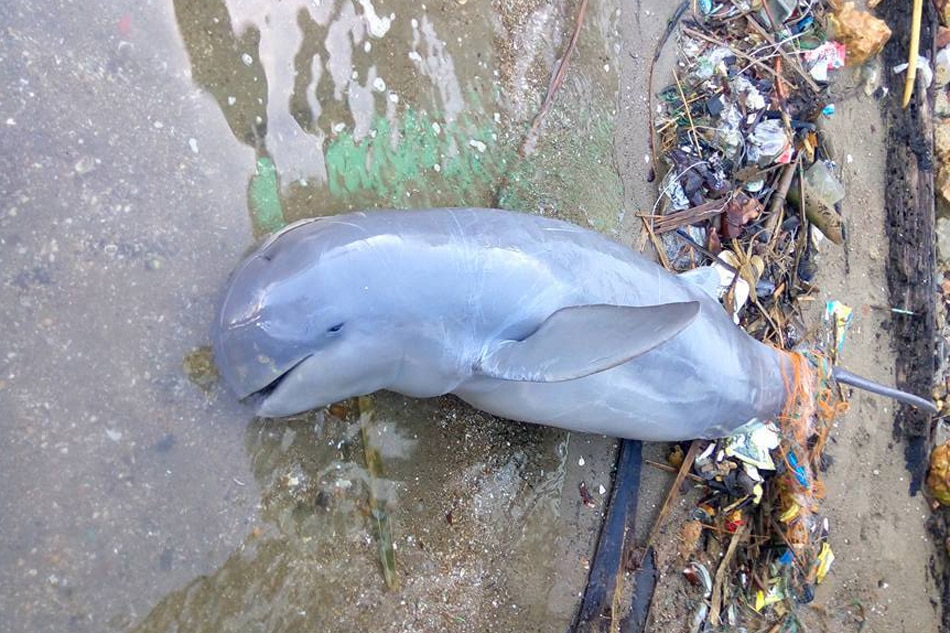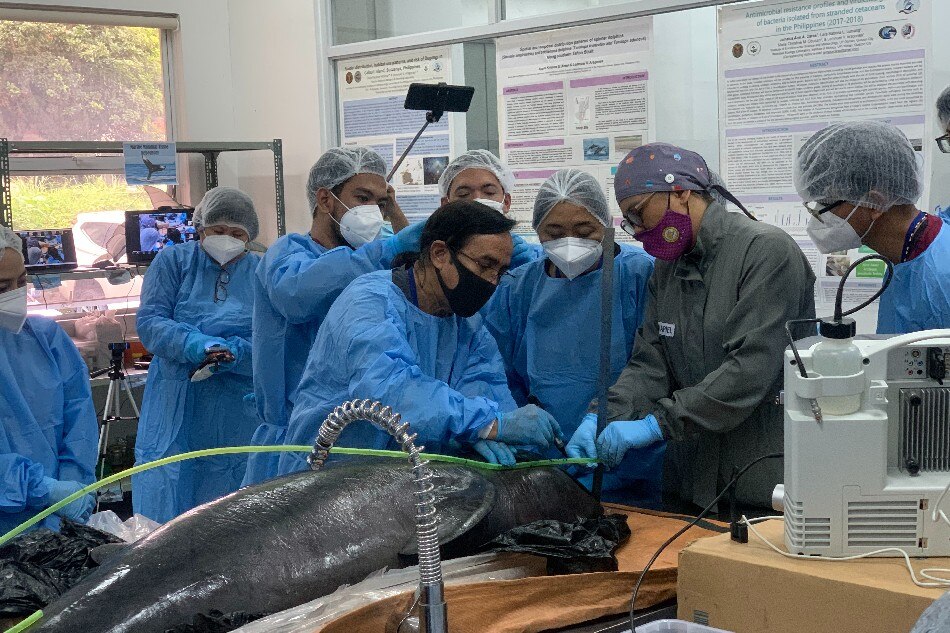Irrawaddy dolphin sighted off Bicol for the first time
ADVERTISEMENT

Welcome, Kapamilya! We use cookies to improve your browsing experience. Continuing to use this site means you agree to our use of cookies. Tell me more!
Irrawaddy dolphin sighted off Bicol for the first time
ABS-CBN News
Published Sep 28, 2022 08:37 PM PHT
MANILA — Scientists of the University of the Philippines (UP) are excited about the possibility of a yet undiscovered marine biodiversity off the shores of Calabanga, Camarines Sur after an Irrawaddy dolphin was sighted there for the first time.
MANILA — Scientists of the University of the Philippines (UP) are excited about the possibility of a yet undiscovered marine biodiversity off the shores of Calabanga, Camarines Sur after an Irrawaddy dolphin was sighted there for the first time.
But they also express concern as the endangered dolphin, nicknamed "Calab" by marine authorities, died after being entangled in a fisherman's net last August, according to a statement from the UP Diliman College of Science on Wednesday.
But they also express concern as the endangered dolphin, nicknamed "Calab" by marine authorities, died after being entangled in a fisherman's net last August, according to a statement from the UP Diliman College of Science on Wednesday.
Autopsy findings showed that Calab, a female dolphin, still had undigested fish in its stomach, indicating that she died "suddenly and unexpectedly."
Autopsy findings showed that Calab, a female dolphin, still had undigested fish in its stomach, indicating that she died "suddenly and unexpectedly."
“Calab’s death is an unfortunate incident, but it has paved the way to learning more about these rare and beautiful creatures,” Dr. Lemnuel Aragones, the president of the Philippine Marine Mammals Stranding Network (PMMSN) and a professor at UP Diliman's Institute of Environmental Science and Meteorology (IESM), was quoted in the statement.
“Calab’s death is an unfortunate incident, but it has paved the way to learning more about these rare and beautiful creatures,” Dr. Lemnuel Aragones, the president of the Philippine Marine Mammals Stranding Network (PMMSN) and a professor at UP Diliman's Institute of Environmental Science and Meteorology (IESM), was quoted in the statement.
ADVERTISEMENT
This was the first time that an Irrawaddy dolphin was found on the Pacific or eastern side of the Philippines, the college said.
This was the first time that an Irrawaddy dolphin was found on the Pacific or eastern side of the Philippines, the college said.
Apart from other populations in South and Southeast Asia, previous sightings of the dolphin in the Philippines were exclusively at the western part of the country, such as in Malampaya Sound, Palawan, and in the Iloilo-Guimaras Strait.
Apart from other populations in South and Southeast Asia, previous sightings of the dolphin in the Philippines were exclusively at the western part of the country, such as in Malampaya Sound, Palawan, and in the Iloilo-Guimaras Strait.
Experts have yet to understand how Irrawaddy dolphins found their way to Palawan, Iloilo, and Bicol.
Experts have yet to understand how Irrawaddy dolphins found their way to Palawan, Iloilo, and Bicol.
Aragones suggested that they might have been there since prehistoric times, before humans arrived in the archipelago and possibly even before humans existed at all, when environmental conditions were likely optimal for widespread migration.
Aragones suggested that they might have been there since prehistoric times, before humans arrived in the archipelago and possibly even before humans existed at all, when environmental conditions were likely optimal for widespread migration.
“Basically, the populations have been there for a very long time, we just didn’t know to look for them,” he said.
“Basically, the populations have been there for a very long time, we just didn’t know to look for them,” he said.
ADVERTISEMENT
Irrawaddy dolphins typically have gray or dark-blue backs and pale bellies.
Irrawaddy dolphins typically have gray or dark-blue backs and pale bellies.
Having a high tolerance to various levels of salinity, these dolphins can live in areas where seawater and freshwater meet, such as the mouths of rivers and bays.
Having a high tolerance to various levels of salinity, these dolphins can live in areas where seawater and freshwater meet, such as the mouths of rivers and bays.
They are among the world’s most endangered dolphin species, having been classified as critically endangered on the Red List of the International Union for Conservation of Nature (IUCN) and Department of Environment and Natural Resources (DENR).
They are among the world’s most endangered dolphin species, having been classified as critically endangered on the Red List of the International Union for Conservation of Nature (IUCN) and Department of Environment and Natural Resources (DENR).
Aragones noted that Calab is proof that there is still so much yet to be discovered in the Philippines’ richly biodiverse waters.
Aragones noted that Calab is proof that there is still so much yet to be discovered in the Philippines’ richly biodiverse waters.
He and his team of marine mammal scientists and local BFAR personnel are scheduled to visit San Miguel Bay to hopefully find more Irrawaddy dolphins and study them in their natural habitat.
He and his team of marine mammal scientists and local BFAR personnel are scheduled to visit San Miguel Bay to hopefully find more Irrawaddy dolphins and study them in their natural habitat.
ADVERTISEMENT
UP scientists expressed concern that without a proper survey and understanding of the area’s ecosystems, unregulated human activity could kill off not just Irrawaddy dolphins but other possible as-yet undiscovered species in the area.
UP scientists expressed concern that without a proper survey and understanding of the area’s ecosystems, unregulated human activity could kill off not just Irrawaddy dolphins but other possible as-yet undiscovered species in the area.
"Unsustainable and illegal fishing practices as well as poorly-planned infrastructure threaten to disrupt local marine environments and biodiversity even before scientists have a chance to study them," they said.
"Unsustainable and illegal fishing practices as well as poorly-planned infrastructure threaten to disrupt local marine environments and biodiversity even before scientists have a chance to study them," they said.
Read More:
Irrawaddy dolphin
dolphin
Camarines Sur
marine biodiversity
University of the Philippines
UP College of Science
endangered species
critically endangered species
environment
marine environment
ADVERTISEMENT
ADVERTISEMENT




